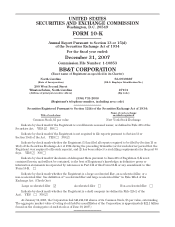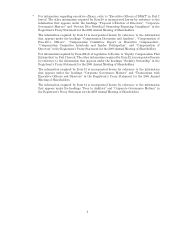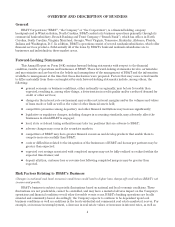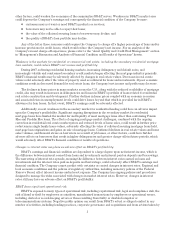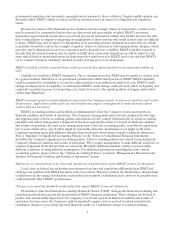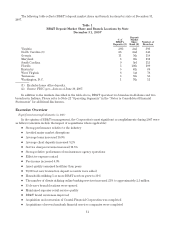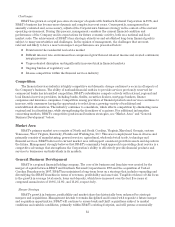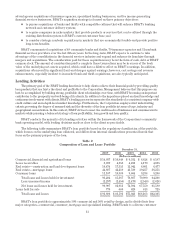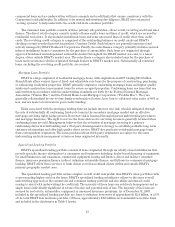BB&T 2007 Annual Report Download - page 5
Download and view the complete annual report
Please find page 5 of the 2007 BB&T annual report below. You can navigate through the pages in the report by either clicking on the pages listed below, or by using the keyword search tool below to find specific information within the annual report.other factors, could weaken the economies of the communities BB&T serves. Weakness in BB&T’s market area
could depress the Company’s earnings and consequently the financial condition of the Company because:
Šcustomers may not want or need BB&T’s products or services;
Šborrowers may not be able to repay their loans;
Šthe value of the collateral securing loans to borrowers may decline; and
Šthe quality of BB&T’s loan portfolio may decline.
Any of the latter three scenarios could require the Company to charge off a higher percentage of loans and/or
increase provisions for credit losses, which would reduce the Company’s net income. For an analysis of the
Company’s recent charge-off experience, please refer to the “Asset Quality and Credit Risk Management” section
in “Management’s Discussion and Analysis of Financial Condition and Results of Operations” herein.
Weakness in the markets for residential or commercial real estate, including the secondary residential mortgage
loan markets, could reduce BB&T’s net income and profitability.
During 2007, softening residential housing markets, increasing delinquency and default rates, and
increasingly volatile and constrained secondary credit markets began affecting the mortgage industry generally.
BB&T’s financial results may be adversely affected by changes in real estate values. Decreases in real estate
values could adversely affect the value of property used as collateral for loans and investments. If poor economic
conditions result in decreased demand for real estate loans, the Company’s net income and profits may decrease.
The declines in home prices in many markets across the U.S., along with the reduced availability of mortgage
credit, also may result in increases in delinquencies and losses in BB&T’s portfolio of loans related to residential
real estate construction and development. Further declines in home prices coupled with an economic recession
and associated rises in unemployment levels could drive losses beyond that which is provided for in BB&T’s
allowance for loan losses. In that event, BB&T’s earnings could be adversely affected.
Additionally, recent weakness in the secondary market for residential lending could have an adverse impact
upon the Company’s profitability. Significant ongoing disruptions in the secondary market for residential
mortgage loans have limited the market for and liquidity of most mortgage loans other than conforming Fannie
Mae and Freddie Mac loans. The effects of ongoing mortgage market challenges, combined with the ongoing
correction in residential real estate market prices and reduced levels of home sales, could result in further price
reductions in single family home values, adversely affecting the value of collateral securing mortgage loans held,
mortgage loan originations and gains on sale of mortgage loans. Continued declines in real estate values and home
sales volumes, and financial stress on borrowers as a result of job losses, or other factors, could have further
adverse effects on borrowers that result in higher delinquencies and greater charge-offs in future periods, which
would adversely affect BB&T’s financial condition or results of operations.
Changes in interest rates may have an adverse effect on BB&T’s profitability.
BB&T’s earnings and financial condition are dependent to a large degree upon net interest income, which is
the difference between interest earned from loans and investments and interest paid on deposits and borrowings.
The narrowing of interest rate spreads, meaning the difference between interest rates earned on loans and
investments and the interest rates paid on deposits and borrowings, could adversely affect BB&T’s earnings and
financial condition. The Company cannot predict with certainty or control changes in interest rates. Regional and
local economic conditions and the policies of regulatory authorities, including monetary policies of the Federal
Reserve Board, affect interest income and interest expense. The Company has ongoing policies and procedures
designed to manage the risks associated with changes in market interest rates. However, changes in interest
rates still may have an adverse effect on BB&T’s profitability.
BB&T faces significant operational risk.
BB&T is exposed to many types of operational risk, including reputational risk, legal and compliance risk, the
risk of fraud or theft by employees or outsiders, unauthorized transactions by employees or operational errors,
including clerical or record-keeping errors or those resulting from faulty or disabled computer or
telecommunications systems. Negative public opinion can result from BB&T’s actual or alleged conduct in any
number of activities, including lending practices, corporate governance and acquisitions and from actions taken by
5

